Theory 2- Motivation Herzberg&Maslow 马斯洛员工激励理论
- 格式:doc
- 大小:58.00 KB
- 文档页数:3
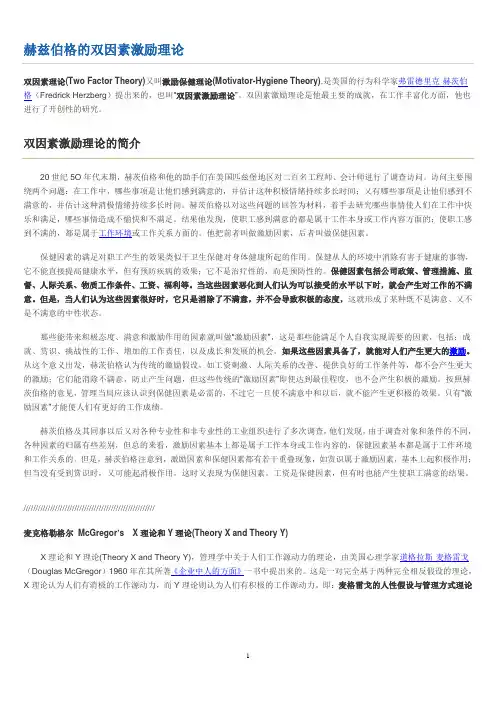
赫兹伯格的双因素激励理论双因素理论(Two Factor Theory)又叫激励保健理论(Motivator-Hygiene Theory),是美国的行为科学家弗雷德里克·赫茨伯格(Fredrick Herzberg)提出来的,也叫“双因素激励理论”。
双因素激励理论是他最主要的成就,在工作丰富化方面,他也进行了开创性的研究。
双因素激励理论的简介20世纪5O年代末期,赫茨伯格和他的助手们在美国匹兹堡地区对二百名工程师、会计师进行了调查访问。
访问主要围绕两个问题:在工作中,哪些事项是让他们感到满意的,并估计这种积极情绪持续多长时间;又有哪些事项是让他们感到不满意的,并估计这种消极情绪持续多长时间。
赫茨伯格以对这些问题的回答为材料,着手去研究哪些事情使人们在工作中快乐和满足,哪些事情造成不愉快和不满足。
结果他发现,使职工感到满意的都是属于工作本身或工作内容方面的;使职工感到不满的,都是属于工作环境或工作关系方面的。
他把前者叫做激励因素,后者叫做保健因素。
保健因素的满足对职工产生的效果类似于卫生保健对身体健康所起的作用。
保健从人的环境中消除有害于健康的事物,它不能直接提高健康水平,但有预防疾病的效果;它不是治疗性的,而是预防性的。
保健因素包括公司政策、管理措施、监督、人际关系、物质工作条件、工资、福利等。
当这些因素恶化到人们认为可以接受的水平以下时,就会产生对工作的不满意。
但是,当人们认为这些因素很好时,它只是消除了不满意,并不会导致积极的态度,这就形成了某种既不是满意、又不是不满意的中性状态。
那些能带来积极态度、满意和激励作用的因素就叫做“激励因素”,这是那些能满足个人自我实现需要的因素,包括:成就、赏识、挑战性的工作、增加的工作责任,以及成长和发展的机会。
如果这些因素具备了,就能对人们产生更大的激励。
从这个意义出发,赫茨伯格认为传统的激励假设,如工资刺激、人际关系的改善、提供良好的工作条件等,都不会产生更大的激励;它们能消除不满意,防止产生问题,但这些传统的“激励因素”即使达到最佳程度,也不会产生积极的激励。
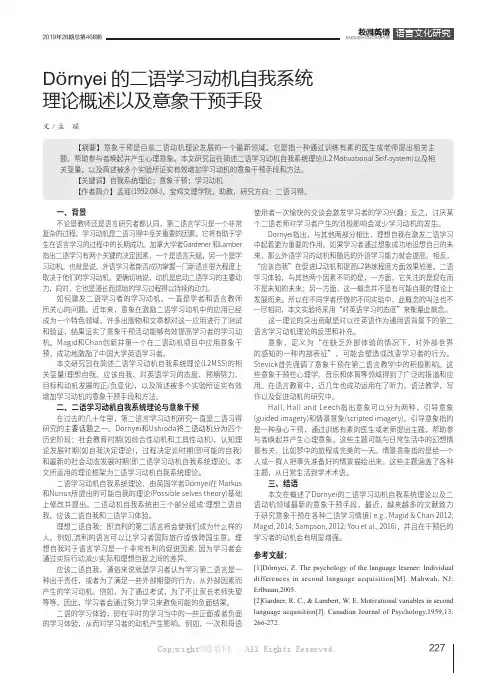
2019年28期总第468期ENGLISH ON CAMPUSDörnyei的二语学习动机自我系统理论概述以及意象干预手段文/孟 瑶一、背景不论是教师还是语言研究者都认同,第二语言学习是一个非常复杂的过程,学习动机是二语习得中至关重要的因素,它将有助于学生在语言学习的过程中的长期成功。
加拿大学者Gardener 和Lamber 指出二语学习有两个关键的决定因素,一个是语言天赋,另一个是学习动机。
也就是说,外语学习者能否成功掌握一门新语言很大程度上取决于他们的学习动机。
更确切地说,动机是启动二语学习的主要动力,同时,它也是漫长而烦琐的学习过程得以持续的动力。
如何激发二语学习者的学习动机,一直是学者和语言教师所关心的问题。
近年来,意象在激励二语学习动机中的应用已经成为一个特色领域,许多出版物和文章都对这一应用进行了测试和验证,结果证实了意象干预活动能够有效提高学习者的学习动机。
Magid和Chan创新并第一个在二语动机项目中应用意象干预,成功地激励了中国大学英语学习者。
本文研究旨在简述二语学习动机自我系统理论(L2MSS)的相关变量(理想自我、应该自我、对英语学习的态度、预期努力、目标和动机发展的正/负变化),以及简述被多个实验所证实有效增加学习动机的意象干预手段和方法。
二、二语学习动机自我系统理论与意象干预在过去的几十年里,第二语言学习动机研究一直是二语习得研究的主要话题之一。
Dörnyei和Ushioda将二语动机分为四个历史阶段:社会教育时期(如综合性动机和工具性动机),认知理论发展时期(如自我决定理论),过程决定论时期(即可能的自我)和最新的社会动态发展时期(即二语学习动机自我系统理论)。
本文所运用的理论框架为二语学习动机自我系统理论。
二语学习动机自我系统理论,由英国学者Dörnyei在 Markus 和Nurius所提出的可能自我的理论(Possible selves theory)基础上修改并提出。

第一节内容型激励理论激励就是激发员工的工作动机,以促使个体有效地完成组织目标。
在现实生活中,一些能力并不怎么强的人,往往通过自己的主观努力而晋升到较高的地位,取得较大的成绩,就是由于他们通过强烈的内驱力的激发而获得的。
激励理论在科学管理中占有特别重要的地位,围绕着这个问题,心理学家进行了大量的研究,并形成了较有代表性的内容激励理论和过程激励理论。
本节首先介绍以马斯洛的需要层次理论、阿尔德佛的ERG理论和赫茨伯格的双因素理论为代表的内容激励理论。
一、马斯洛的需要层次理论需要层次理论(needshieraechytheory)是由美国心理学家(AbrahamMaslow)在1943年提出来的。
这一理论流传甚广,目前已成为世界各国普遍熟悉的理论。
马斯洛认为,人的需要是有层次的,按照他们的重要程序和发生顺序,呈梯形状态由低级向高级需要发展。
人的需要主要包括:生理需要、安全需要、社会需要、自尊需要和自我实现的需要。
需要总是由低到高,逐步上升的,每当低一级的需要获得满足以后,接着高一级的需要就要求满足。
由于各人动机结构的发展情况不同,这五种需要在个体内所形成的优势动机也不相同。
当然,这并不是说当需要发展到高层次之后,低层次的需要就消失了;恰恰相反,低层次的需要仍将继续存在,有时甚至还是十分强烈的。
为此,马斯洛曾经指出,要了解员工的态度和情绪,就必须了解他们的基本需要。
(一)需要层次的基本结构马斯洛的需要层次理论,可用图3-1表示。
在图3-1中,1、2两层可以被看成是低级需要,它们偏重于对物质的需求;3、4、5三层可以被看成是高级需要,它们偏重于对精神的需求。
对上面五个需要层次,马斯洛进行了如下具体说明:1.生理需要。
生理需要是人最原始、最基本的需要,它包括衣、食、住、行和性等方面的生理要求,是人类赖以生存和繁衍的基本需要,这类需要如果不能满足,人类就不能生存。
从这个意义上说,它是推动人们行为活动最强大的动力。


双因素理论的大师赫茨伯格栏目主编:刘文瑞教授本期主要撰稿人:王肖婧(西北政法大学)编者按:大师思想,实践源泉。
从创刊伊始,《管理学家》杂志每期深入介绍一位管理大师的思想和实践,迄今已六十余位。
读懂大师,读懂管理。
更多系列文章请持续参阅《管理学家》为您呈送的"思想史"栏目。
赫茨伯格以心理学家的身份,主持了著名的匹兹堡调查,提出了双因素理论。
他认为,人们通常认为起激励作用的因素,实际包含两类,一类只起保健作用,另一类起真正的激励作用。
保健因素只能改善人们的工作条件和环境,不能激发工作热情;激励因素蕴含于工作之中,能够满足人们的成长需要,形成内在驱动力。
双因素理论的提出,在管理学界引起了巨大的反响。
它适应了由物质匮乏时代到物质富裕时代的激励主题转变。
从双因素理论出发,赫茨伯格进行了工作丰富化实验。
他严格区分了工作丰富化与工作扩大化的差别,以工作丰富化的方式给予员工更多的自主空间和自治权力,从而促进了分工模式和组织结构的调整,成为新的组织原理之源。
从赫茨伯格以后,组织理论出现了较大的变化。
在机械式组织向有机式组织的转变中,在权责分工型组织向学习型组织的转变中,赫茨伯格起到了承先启后的作用。
了解赫茨伯格的理论,可以使人们对当代管理学发展变化的脉络形成更深刻的认识。
赫茨伯格与匹兹堡调查来源:《管理学家》杂志社作者:王肖婧闻华在各色各样的激励理论中,双因素理论名闻遐迩。
这一理论的提出,源于赫茨伯格主持的匹兹堡调查。
赫茨伯格其人弗雷德里克·赫茨伯格(FrederickIrvingHerzberg,1923-2000),是美国著名的心理学家兼管理学家,也是几乎每种管理学教材在谈到激励理论时肯定会提到的人物。
然而令人遗憾的是,不知是他过于低调,还是学界过于偏颇,这样一位著名学者,关于他的生平几乎找不到多少资料,人们只能从零散的只言片语中窥其一斑。
赫茨伯格1923年生于美国马萨诸塞州林恩市,在纽约市立学院读大学,获得学士学位;后来在匹兹堡大学获得博士学位。
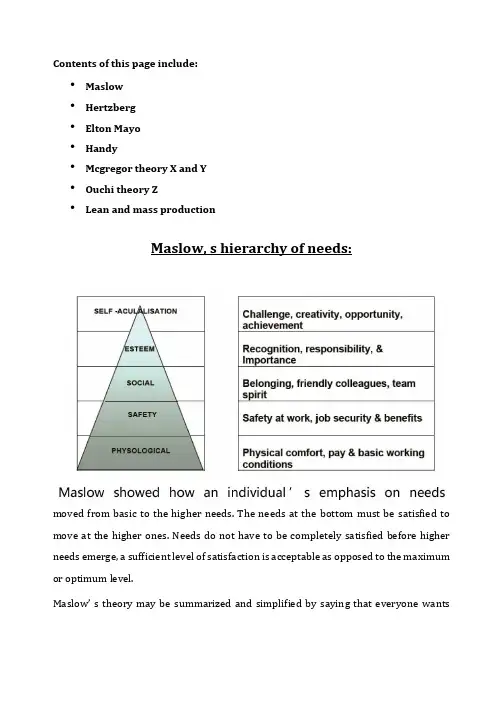
Contents of this page include:•Maslow•Hertzberg•Elton Mayo•Handy•Mcgregor theory X and Y•Ouchi theory Z•Lean and mass productionMaslow, s hierarchy of needs:moved from basic to the higher needs. The needs at the bottom must be satisfied to move at the higher ones. Needs do not have to be completely satisfied before higher needs emerge, a sufficient level of satisfaction is acceptable as opposed to the maximum or optimum level.Maslow’ s theory may be summarized and simplified by saying that everyone wa ntscertain things throughout life, and these things can be placed in five ascending categories namely:Basic or physiological needs: the things needed to stay alive: food, shelter and clothing. Such needs can be satisfied by money.Safety or security needs: people want protection against, unemployment, retirement as well as being safeguarded against unfair treatment. These needs can be satisfied by the rules of employment i.e pension scheme, sick fund, employment legislation.Social needs: the vast majority of people want to be part of a group and it is only through group activity that this need can be satisfied. Thus it is up to the organization to make the employee feel part of a group.Ego or Esteem needs: e.g. can include employee being asked to lead a group in a project. This enables the employee to think well of himself and in his abilities. This can be satisfied if the say or suggestion of the employee is taken into account and/or he is asked to lead or be part of an important task.Self-actualization or self-fulfillment needs: this is quite the need to achieve something worthwhile in life. It is a need that is satisfied only by continuing success, for example opening and running a new office.EVALUATION OF MASLOW:The significance of maslow’ s hierarchy of needs is that if underlines the relative importance of money. Status gives little satisfaction to a person desperate for food and shelter.On the other hand it demonstrates that money alone is not enough, and indeed as basic needs are satisfied people are likely to concentrate their attentions on social and ego needs.Herzberg’ s theory of motivation:Herzberg attempted to find out what motivated people at work. He developed the two-factor theory that was based on the idea that motivation is based on two needs, namely hygiene factors and motivational factors.Hygiene factors: are those that have to do with non-job related features such as the working environment.Motivational factors: are those concerned with a need for personal development.Hygiene factors: factors that need to be met to prevent dissatisfaction. Will not motivate in themselves, they are concerned with extrinsic factors associated with thejob itself but are not directly a part of it. The important fact to remember is that attention to these hygiene factors prevents dissatisfaction but does not necessarily provide positive motivation.•Pay•Conditions•Company policy•Relationships with higher levels, such as management•Treatment at work•Inability to develop•Feelings of inadequacyMotivators: factors which motivate: the main motivation factor are not in the environment but in the intrinsic value and satisfaction gained from the job itself. Motivation factors include:•Sense of achievement•Chance of promotion•Chance of improvement•Recognition of effort•Responsibility•Nature of job itselfElton Mayo (Hawthorne Studies)Mayo’ s most important contribution was to identify the basis of work satisfaction as non-economic and to connect it more with the interest taken in the worker ' s performance than with the financial reward.Okay here’ s what happened in plain simple words:• A test was conducted on 6 women which lasted for five years•The test was conducted so as to observe the effect on output and morale of various changes in working conditions.•Initially, an incentive payment scheme was introduced; then rest periods in different forms. Changes were made in the hours of work etc.•CONCLUSION: it was found that whatever changes were made including a return to the original conditions, output still rose!•The output recorded over time kept on increasing.Evaluation: it was apparent that the changes in working conditions could not account for the increase in output - this was due to the enhanced work satisfaction that the girls enjoyed, the development of personal friendships, and a new social atmosphere, which brought a marked change in their attitude towards work.Mcgregor, s theory X and theory Y:Mcgregor’ s theories:Theory X: assumes that people dislike work and responsibility. Therefore they must be coerced, controlled, directed or threatened with punishment to get them to make an effort towards achievement of organizational objectives. However modern employment laws have made this difficult for managers. For this reason a 'carrot’ approach is used. People have to be persuaded to carry out tasks by promises or rewards. In many ways this is similar to Taylor’ s view.Theory Y:assumes that most people are motivated by those things at the top of Maslow’ s hierarchy. In other words, people are responsible, committ ed and enjoy having control over work. Most people, given the opportunity, will get involved in work and contribute towards the solution of a problem that may arise.IN OTHER WORDS:THEORY X is pessimistic and rigid. Control is primarily external i.e. imposed on the subordinate by the superior.THEORY Y is optimistic, dynamic and flexible, with an emphasis o self-direction and the integration of individual needs with organizational demands.Ouchi theory ZIn theory Z there is an emphasis on the interpersonal skills that form the basis of group working, where decision making is by consensus, but responsibility remains with the individual.There is emphasis on building trust through informal and democratic relationships.The characteristics of the theory z organizations are:•Long term employment•Slow evaluation and promotion•Moderately specialized careers•Consensual decision making•Individual responsibility- this could mean giving greater responsibility lower down the line•Concern for the employeeLEAN PRODUCTIONLean production is divided into the following sectors:•Kaizen•Just in time manufacturing•Time based management •Empowerment •TeamworkingKaizen is perhaps the most concept in Japanese management. It means continuous improvement. In western businesses productivity remains the same for long periods of time, then suddenly rises. The increase is followed by another period of stability, before another rise. Increases in productivity may result from new working practices or new technology. The dotted line below shows the Japanese approach. Improvements are continuous. They result from changes in production techniques.continuousimprovementsone ofjmprovementstimethe kaizen is said to be an umbrella concept. A wide range of different production techniques and working practices must be carried out for it to be effective. These include:•Zero defect policies•Total quality management•Quality control circles•Automation•Just in timeIt is difficult for workers in the business to look for continuous improvement all the time. In order to solve this problem a system was introduced namely PDCA (plan, do, check, action)Plan: business must identify where improvement is needed. Data must be gathered and used to develop a plan which will result in improvement.Do: once the plan has been finalized it must be carried out.Check: the next stage in the cycle is to check whether or not there has been an improvement.Action: if the plan has been successful, it must be introduced in all parts of the business.Just in time manufacturing:JIT: just in time manufacturing is an important part of lean production. It is defined as for example in any manufacturing and selling organization: ‘raw materials being delivered JIT to be made into parts, parts were delivered JIT to be made into goods and goods were produced and delivered JIT to be sold./Advantages:•It improves cash flow as money is not tied up in stock•The system reduces waste•Since no stock is held the excess factory space can be used for something else •Links with and the control of suppliers is improvedDisadvantages:• A lot of faith is placed in the reliability and flexibility of suppliers•Increased order costs•Advantages of bulk discounts is lost•Difficult to cope up with sharp increases in demandTime-based management:Time based mgt involves reducing the amount of time businesses take carrying out certain tasks, such as launching new products or cutting lead times in production. Time based mgt is a feature of lean production because it involves eliminating a type of waste i.e. time.Advantages:•Customers will benefit. A wider range of products will be available and there will be faster delivery times.•Increased efficiency will benefit the company by improving it’ s image in the eyes of the people•The time spent on range of production tasks is reduced. This helps to improve productivity and reduce unit costs.Empowerment:Empowerment involves giving employees the power to make decisions in a business. The aim of empowerment is to give employees more control over their own work conditions.Businesses have now learnt that efficiency will improve if workers are given theopportunity to involve themselves in decision making. Workers will be better motivated and the business may gain from the creativity of its workers.Empowerment is not without difficulties. Some workers may not be able to make their own decisions and training may be required to teach them such skills. Mangers may resent giving up authority. Some staff may even abuse their power to make decisions.Team working:A growing number of businesses are introducing team working. This involves dividing the workforce into fairly small groups. Each team will focus on particular areas of production and team members will have the same common aims.Effective teamworking requires cooperation between workers and management. Both the business and employees can benefit from team working. Workers should develop relationships with colleagues and a team spirit which may improve motivation and productivity. Flexibility will improve. For example team members might be more willing to cover for an absent colleague.MASS production。
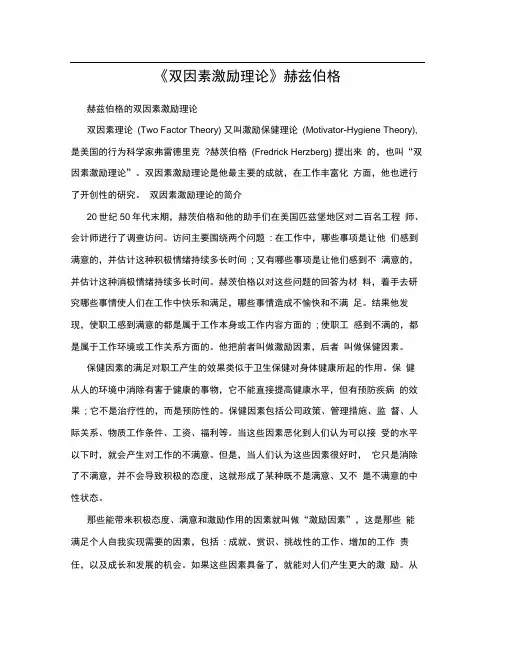
《双因素激励理论》赫兹伯格赫兹伯格的双因素激励理论双因素理论(Two Factor Theory) 又叫激励保健理论(Motivator-Hygiene Theory), 是美国的行为科学家弗雷德里克?赫茨伯格(Fredrick Herzberg) 提出来的,也叫“双因素激励理论”。
双因素激励理论是他最主要的成就,在工作丰富化方面,他也进行了开创性的研究。
双因素激励理论的简介20世纪50年代末期,赫茨伯格和他的助手们在美国匹兹堡地区对二百名工程师、会计师进行了调查访问。
访问主要围绕两个问题: 在工作中,哪些事项是让他们感到满意的,并估计这种积极情绪持续多长时间; 又有哪些事项是让他们感到不满意的,并估计这种消极情绪持续多长时间。
赫茨伯格以对这些问题的回答为材料,着手去研究哪些事情使人们在工作中快乐和满足,哪些事情造成不愉快和不满足。
结果他发现,使职工感到满意的都是属于工作本身或工作内容方面的; 使职工感到不满的,都是属于工作环境或工作关系方面的。
他把前者叫做激励因素,后者叫做保健因素。
保健因素的满足对职工产生的效果类似于卫生保健对身体健康所起的作用。
保健从人的环境中消除有害于健康的事物,它不能直接提高健康水平,但有预防疾病的效果; 它不是治疗性的,而是预防性的。
保健因素包括公司政策、管理措施、监督、人际关系、物质工作条件、工资、福利等。
当这些因素恶化到人们认为可以接受的水平以下时,就会产生对工作的不满意。
但是,当人们认为这些因素很好时,它只是消除了不满意,并不会导致积极的态度,这就形成了某种既不是满意、又不是不满意的中性状态。
那些能带来积极态度、满意和激励作用的因素就叫做“激励因素”,这是那些能满足个人自我实现需要的因素,包括: 成就、赏识、挑战性的工作、增加的工作责任,以及成长和发展的机会。
如果这些因素具备了,就能对人们产生更大的激励。
从这个意义出发,赫茨伯格认为传统的激励假设,如工资刺激、人际关系的改善、提供良好的工作条件等,都不会产生更大的激励; 它们能消除不满意,防止产生问题,但这些传统的“激励因素”即使达到最佳程度,也不会产生积极的激励。
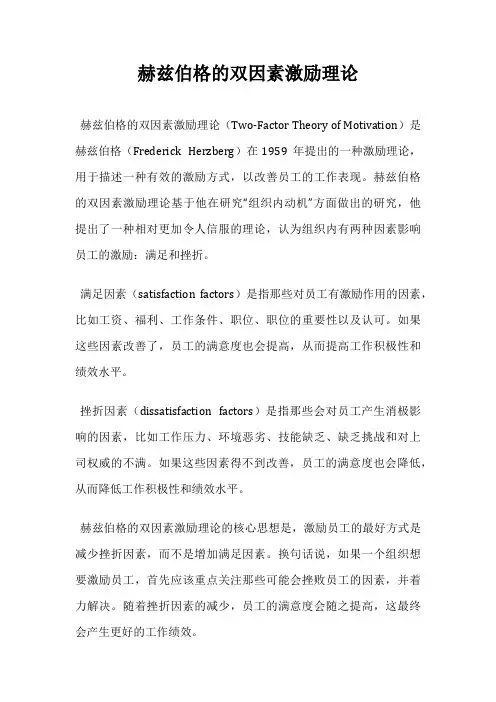
赫兹伯格的双因素激励理论
赫兹伯格的双因素激励理论(Two-Factor Theory of Motivation)是赫兹伯格(Frederick Herzberg)在1959年提出的一种激励理论,用于描述一种有效的激励方式,以改善员工的工作表现。
赫兹伯格的双因素激励理论基于他在研究“组织内动机”方面做出的研究,他提出了一种相对更加令人信服的理论,认为组织内有两种因素影响员工的激励:满足和挫折。
满足因素(satisfaction factors)是指那些对员工有激励作用的因素,比如工资、福利、工作条件、职位、职位的重要性以及认可。
如果这些因素改善了,员工的满意度也会提高,从而提高工作积极性和绩效水平。
挫折因素(dissatisfaction factors)是指那些会对员工产生消极影响的因素,比如工作压力、环境恶劣、技能缺乏、缺乏挑战和对上司权威的不满。
如果这些因素得不到改善,员工的满意度也会降低,从而降低工作积极性和绩效水平。
赫兹伯格的双因素激励理论的核心思想是,激励员工的最好方式是减少挫折因素,而不是增加满足因素。
换句话说,如果一个组织想要激励员工,首先应该重点关注那些可能会挫败员工的因素,并着力解决。
随着挫折因素的减少,员工的满意度会随之提高,这最终会产生更好的工作绩效。
赫兹伯格的双因素激励理论在现今仍然具有重要的指导意义,它提供了一种有效的激励方式,以改善员工的工作表现和积极性。
它还提醒组织管理者,在激励员工时,要重点关注挫折因素,而不是增加满足因素,这样才能真正提高员工的工作积极性。
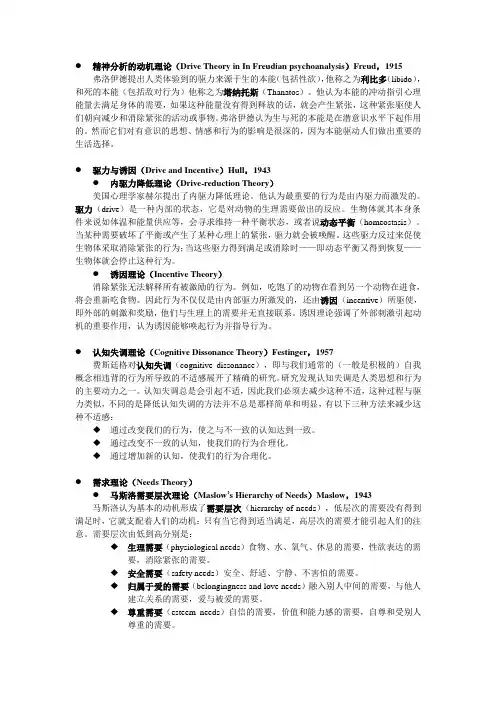
●精神分析的动机理论(Drive Theory in In Freudian psychoanalysis)Freud,1915弗洛伊德提出人类体验到的驱力来源于生的本能(包括性欲),他称之为利比多(libido),和死的本能(包括敌对行为)他称之为塔纳托斯(Thanatos)。
他认为本能的冲动指引心理能量去满足身体的需要,如果这种能量没有得到释放的话,就会产生紧张,这种紧张驱使人们朝向减少和消除紧张的活动或事物。
弗洛伊德认为生与死的本能是在潜意识水平下起作用的。
然而它们对有意识的思想、情感和行为的影响是很深的,因为本能驱动人们做出重要的生活选择。
●驱力与诱因(Drive and Incentive)Hull,1943●内驱力降低理论(Drive-reduction Theory)美国心理学家赫尔提出了内驱力降低理论。
他认为最重要的行为是由内驱力而激发的。
驱力(drive)是一种内部的状态,它是对动物的生理需要做出的反应。
生物体就其本身条件来说如体温和能量供应等,会寻求维持一种平衡状态,或者说动态平衡(homeostasis)。
当某种需要破坏了平衡或产生了某种心理上的紧张,驱力就会被唤醒。
这些驱力反过来促使生物体采取消除紧张的行为;当这些驱力得到满足或消除时——即动态平衡又得到恢复——生物体就会停止这种行为。
●诱因理论(Incentive Theory)消除紧张无法解释所有被激励的行为。
例如,吃饱了的动物在看到另一个动物在进食,将会重新吃食物。
因此行为不仅仅是由内部驱力所激发的,还由诱因(incentive)所驱使,即外部的刺激和奖励,他们与生理上的需要并无直接联系。
诱因理论强调了外部刺激引起动机的重要作用,认为诱因能够唤起行为并指导行为。
●认知失调理论(Cognitive Dissonance Theory)Festinger,1957费斯廷格对认知失调(cognitive dissonance),即与我们通常的(一般是积极的)自我概念相违背的行为所导致的不适感展开了精确的研究。

《双因素激励理论》赫兹伯格赫兹伯格的双因素激励理论双因素理论(Two Factor Theory)又叫激励保健理论(Motivator-Hygiene Theory),是美国的行为科学家弗雷德里克?赫茨伯格(Fredrick Herzberg)提出来的,也叫“双因素激励理论”。
双因素激励理论是他最主要的成就,在工作丰富化方面,他也进行了开创性的研究。
双因素激励理论的简介20世纪5O年代末期,赫茨伯格和他的助手们在美国匹兹堡地区对二百名工程师、会计师进行了调查访问。
访问主要围绕两个问题:在工作中,哪些事项是让他们感到满意的,并估计这种积极情绪持续多长时间;又有哪些事项是让他们感到不满意的,并估计这种消极情绪持续多长时间。
赫茨伯格以对这些问题的回答为材料,着手去研究哪些事情使人们在工作中快乐和满足,哪些事情造成不愉快和不满足。
结果他发现,使职工感到满意的都是属于工作本身或工作内容方面的;使职工感到不满的,都是属于工作环境或工作关系方面的。
他把前者叫做激励因素,后者叫做保健因素。
保健因素的满足对职工产生的效果类似于卫生保健对身体健康所起的作用。
保健从人的环境中消除有害于健康的事物,它不能直接提高健康水平,但有预防疾病的效果;它不是治疗性的,而是预防性的。
保健因素包括公司政策、管理措施、监督、人际关系、物质工作条件、工资、福利等。
当这些因素恶化到人们认为可以接受的水平以下时,就会产生对工作的不满意。
但是,当人们认为这些因素很好时,它只是消除了不满意,并不会导致积极的态度,这就形成了某种既不是满意、又不是不满意的中性状态。
那些能带来积极态度、满意和激励作用的因素就叫做“激励因素”,这是那些能满足个人自我实现需要的因素,包括:成就、赏识、挑战性的工作、增加的工作责任,以及成长和发展的机会。
如果这些因素具备了,就能对人们产生更大的激励。
从这个意义出发,赫茨伯格认为传统的激励假设,如工资刺激、人际关系的改善、提供良好的工作条件等,都不会产生更大的激励;它们能消除不满意,防止产生问题,但这些传统的“激励因素”即使达到最佳程度,也不会产生积极的激励。

概述双因素理论 (Two Factors Theory)又称激励保健理论(Motivator-Hygiene Theory),是美国的行为科学家弗雷德里克·赫茨伯格(Fredrick Herzberg)提出来的。
双因素理论认为引起人们工作动机的因素主要有两个:一是保健因素,二是激励因素。
只有激励因素才能够给人们带来满意感,而保健因素只能消除人们的不满,但不会带来满意感。
其理论根据是:第一,不是所有的需要得到满足就能激励起人们的积极性,只有那些被称为激励因素的需要得到满足才能调动人们的积极性;第二,不具备保健因素时将引起强烈的不满,但具备时并不一定会调动强烈的积极性;第三,激励因素是以工作为核心的,主要是在职工进行工作时发生的。
保健因素保健因素是指造成员工不满的因素。
保健因素不能得到满足,则易使员工产生不满情绪、消极怠工,甚至引起罢工等对抗行为;但在保健因素得到一定程度改善以后,无论再如何进行改善的努力往往也很难使员工感到满意,因此也就难以再由此激发员工的工作积极性,所以就保健因素来说:“不满意”的对立面应该是“没有不满意”。
激励因素激励因素是指能造成员工感到满意的因素。
激励因素的改善而使员工感到满意的结果,能够极大地激发员工工作的热情,提高劳动生产效率;但激励因素即使管理层不给予其满意满足,往往也不会因此使员工感到不满意,所以就激励因素来说:“满意”的对立面应该是“没有不满意”。
(国内各教科书翻译为:不满意的对立面为没有不满意,等于是说没保健因素时不满意,有保健因素时也没有什么不满意;满意的对立面为没有满意,等于是说有激励因素时会感到满意,没有激励因素时也感不到满意。
逻辑混乱,且与赫茨伯格原意不符,显然是原翻译错误,而教科书又长期错误运用,所以特加以修改并加以说明。
欢迎有原文者提供原文资料并给予批评)。
双因素激励理论的谬误1、双因素以满意不满意作为判断员工是否具有积极主动性的标准具有主观性。
Contents of this page include:∙Maslow∙Hertzberg∙Elton Mayo∙Handy∙Mcgregor theory X and Y∙Ouchi theory Z∙Lean and mass productionMaslow’s hierarchy of needs:Maslow showed how an individual’s emphasis on needs moved from basic to the higher needs. The needs at the bottom must be satisfied to move at the higher ones. Needs do not have to be completely satisfied before higher needs emerge, a sufficient level of satisfaction is acceptable as opposed to the maximum or optimum level.Maslow’s theory may be summarized and simplified by saying that everyone wants certain things throughout life, and these things can be placed in five ascending categories namely:Basic or physiological needs: the things needed to stay alive: food, shelter and clothing. Such needs can be satisfied by money.Safety or security needs: people want protection against, unemployment, retirement as well as being safeguarded against unfair treatment. These needs can be satisfied by the rules of employment i.e pension scheme, sick fund, employment legislation.Social needs: the vast majority of people want to be part of a group and it is only through group activity that this need can be satisfied. Thus it is up to the organization to make the employee feel part of a group.Ego or Esteem needs: e.g. can include employee being asked to lead a group in a project. This enables the employee to think well of himself and in his abilities. This can be satisfied if the say or suggestion of the employee is taken into account and/or he is asked to lead or be part of an important task.Self-actualization or self-fulfillment needs: this is quite the need to achieve something worthwhile in life. It is a need that is satisfied only by continuing success, for example opening and running a new office.EVALUATION OF MASLOW:The significance of maslow’s hierarchy of needs is that if underlines the relative importance of money. Status gives little satisfaction to a person desperate for food and shelter.On the other hand it demonstrates that money alone is not enough, and indeed as basic needs are satisfied people arelikely to concentrate their attentions on social and ego needs.Herzberg’s theory of motivation:Herzberg attempted to find out what motivated people at work. He developed the two-factor theory that was based on the idea that motivation is based on two needs, namely hygiene factors and motivational factors.Hygiene factors: are those that have to do with non-job related features such as the working environment.Motivational factors: are those concerned with a need for personal development.Hygiene factors: factors that need to be met to prevent dissatisfaction. Will not motivate in themselves, they are concerned with extrinsic factors associated with the job itself but are not directly a part of it. The important fact to remember is that attention to these hygiene factors prevents dissatisfaction but does not necessarily provide positive motivation.Pay∙Conditions∙Company policy∙Relationships with higher levels, such as management∙Treatment at work∙Inability to develop∙Feelings of inadequacyMotivators: factors which motivate: the main motivation factor are not in the environment but in the intrinsic value and satisfaction gained from the job itself. Motivation factors include:∙Sense of achievement∙Chance of promotion∙Chance of improvement∙Recognition of effort∙Responsibility∙Nature of job itselfElton Mayo (Hawthorne Studies)Mayo’s most important contribution was to identify the basis of work satisfaction as non-economic and to connect it more with the interest taken in the worker’s performance than with the financial reward.Okay here’s what happened in plain simple words:∙ A test was conducted on 6 women which lasted for five years ∙The test was conducted so as to observe the effect on output and morale of various changes in working conditions. ∙Initially, an incentive payment scheme was introduced; then rest periods in different forms. Changes were made in the hours of work etc.∙CONCLUSION: it was found that whatever changes were made including a return to the original conditions, output still rose!∙The output recorded over time kept on increasing.Evaluation: it was apparent that the changes in working conditions could not account for the increase in output –this was due to the enhanced work satisfaction that the girls enjoyed, the development of personal friendships, and a new social atmosphere, which brought a marked change in their attitude towards work.Mcgregor’s theories:Theory X: assumes that people dislike work and responsibility. Therefore they must be coerced, controlled, directed or threatened with punishment to get them to make an effort towards achievement of organizational objectives. However modern employment laws have made this difficult for managers. For this reason a ‘carrot’ approach is used. People have to be persuaded to carry out tasks by promises or rewards. In many ways this is similar to Taylor’s view.Theory Y: assumes that most people are motivated by those things at the top of Maslow’s hierarchy. In other words, people are responsible, committed and enjoy having control over work. Most people, given the opportunity, will get involved in work and contribute towards the solution of a problem that may arise.IN OTHER WORDS:THEORY X is pessimistic and rigid. Control is primarily external i.e. imposed on the subordinate by the superior.THEORY Y is optimistic, dynamic and flexible, with an emphasis o self-direction and the integration of individual needs with organizational demands.Ouchi theory ZIn theory Z there is an emphasis on the interpersonal skills that form the basis of group working, where decision making is by consensus, but responsibility remains with the individual.There is emphasis on building trust through informal and democratic relationships.The characteristics of the theory z organizations are:∙Long term employment∙Slow evaluation and promotion∙Moderately specialized careers∙Consensual decision making∙Individual responsibility- this could mean giving greater responsibility lower down the line∙Concern for the employeeLEAN PRODUCTIONLean production is divided into the following sectors: ∙Kaizen∙Just in time manufacturing∙Time based management∙Empowerment∙TeamworkingKaizen is perhaps the most concept in Japanese management. It means continuous improvement. In western businesses productivity remains the same for long periods of time, then suddenly rises. The increase is followed by another period of stability, before another rise. Increases in productivity may result from new working practices or new technology. The dotted line below shows the Japanese approach. Improvements are continuous. They result from changes in production techniques.the kaizen is said to be an umbrella concept. A wide range of different production techniques and working practices must be carried out for it to be effective. These include:∙Zero defect policies∙Total quality management∙Quality control circles∙Automation∙Just in timeIt is difficult for workers in the business to look for continuous improvement all the time. In order to solve this problem a system was introduced namely PDCA (plan, do, check, action)Plan: business must identify where improvement is needed. Data must be gathered and used to develop a plan which will result in improvement.Do: once the plan has been finalized it must be carried out. Check: the next stage in the cycle is to check whether or not there has been an improvement.Action: if the plan has been successful, it must be introduced in all parts of the business.Just in time manufacturing:JIT: just in time manufacturing is an important part of lean production. It is defined as for example in any manufacturing and selling organization: ‘raw materials being delivered JIT to be made into parts, parts were delivered JIT to be made into goods and goods were produced and delivered JIT to be sold.’Advantages:∙It improves cash flow as money is not tied up in stock∙The system reduces waste∙Since no stock is held the excess factory space can be used for something else∙Links with and the control of suppliers is improvedDisadvantages:∙ A lot of faith is placed in the reliability and flexibility of suppliers∙Increased order costs∙Advantages of bulk discounts is lost∙Difficult to cope up with sharp increases in demandTime-based management:Time based mgt involves reducing the amount of time businesses take carrying out certain tasks, such as launching new products or cutting lead times in production. Time based mgt is a feature of lean production because it involves eliminating a type of waste i.e. time.Advantages:∙Customers will benefit. A wider range of products will be available and there will be faster delivery times.∙Increased efficiency will benefit the company by improving it’s image in the eyes of the people∙The time spent on range of production tasks is reduced.This helps to improve productivity and reduce unit costs.Empowerment:Empowerment involves giving employees the power to make decisions in a business. The aim of empowerment is to give employees more control over their own work conditions.Businesses have now learnt that efficiency will improve if workers are given the opportunity to involve themselves in decision making. Workers will be better motivated and the business may gain from the creativity of its workers.Empowerment is not without difficulties. Some workers may not be able to make their own decisions and training may be required to teach them such skills. Mangers may resent giving up authority. Some staff may even abuse their power to make decisions.Team working:A growing number of businesses are introducing team working. This involves dividing the workforce into fairly small groups. Each team will focus on particular areas of production and team members will have the same common aims.Effective teamworking requires cooperation between workers and management. Both the business and employees can benefit from team working. Workers should develop relationships with colleagues and a team spirit which may improve motivation and productivity. Flexibility will improve. For example team members might be more willing to cover for an absent colleague.MASS production。
双因素激励理论(Two factor motivation theory)Sun Zhongshan said, to achieve civilization prosperity, must be the pain of civilizationJackieTwo factor motivation theoryTwo factor theory of motivation and incentive theory called a health factors, is the American behavioral scientist Frederic Herzberg (Fredrick Herzberg) proposed. Two factor theory is his main achievement in the work experience, he has done pioneering research.brief introductionAt the end of 1950s, Herzberg and his aides in the Pittsburgh region of the United States of two hundred engineers, accountants of the survey. Access is mainly about two problems: in the work, what matters is to their satisfaction, and estimate the positive mood last long; what matters is that they are not satisfied, and estimate the duration of negative emotions. Herzberg responded to these questions and started to look at what makes people happy and satisfied at work, and what causes unhappiness and unhappiness. As a result, he found that the satisfaction of the workers is the work itself or the content of the work; the dissatisfaction of the staff is attributed to the work environment or work relationship. He calls the former the motivating factor, the latter as the health factor.EffectThe satisfaction of health care factors is similar to the effect of health care on the health of workers. Health care removes harmful things from the human environment. It does not directly improve health, but has the effect of preventing disease; it is not therapeutic, but preventive. Health care factors include company policies, management measures, supervision, interpersonal relations, material working conditions, wages, welfare, etc.. When these factors deteriorate to below acceptable levels, job dissatisfaction arises. However, when people think that these factors are good, it just eliminates the dissatisfaction, and does not lead to positive attitude, which forms a neutral state that is neither satisfied nor dissatisfied.Those factors can bring positive attitude, satisfaction and motivation are called "incentives", this is who can meet the need of individual self realization factors, including: achievement, appreciation, challenging work, increase work responsibilities, and the opportunity of growth and development. If these factors are available, they will have greater incentives for people. From this point, Herzberg believes that the traditional incentive hypothesis, such as wages, stimulate the improvement of interpersonal relationship, provide good working conditions, will not have a greater incentive; they can eliminate dissatisfaction, prevent problems, but the traditional "incentive" even to the best level, will not have a positive incentive. Herzberg and colleagues later on a variety of professional and non professional industrial organization undertook survey, they found that the investigation object and the differentconditions of various factors attributable to some differences, but overall, the incentive factors basically belong to a work or work contents, health factors are the basic work the environment and working relationship.Incentive factors and health care factorsHerzberg (Herzberg) as the dual factor theory, hierarchy of needs theory, Mcclelland and Maslow's achievement motivation theory, the key lies in trying to persuade employees to pay attention to some of the performance related reasons. It is one of the most controversial motivational theories, perhaps because it has two unique aspects. First of all, this theory emphasizes that some factors can lead to job satisfaction, while others can only prevent dissatisfaction; secondly, the job satisfaction and satisfaction does not exist in a single continuum.The relationship between job satisfaction and productivity by Herzberg on a group of accountants and engineers, through semi organized interviews, he accumulated a variety of factors affecting these personnel on the feelings of the data shows that there are two kinds of different factors.Incentive factorsIt includes work itself, recognition, achievement and responsibility,These factors involve the positive emotions of work, and the content of the work itself. These positive emotions andpersonal past achievements are related to perceived responsibility and responsibility, and they are based on persistent, rather than short-lived, achievements in the work environment.Health factorIt includes company policy and management, technical supervision, salary, working condition and interpersonal relationship, etc.. These factors are related to the negative factors of the work, and also to the atmosphere and environment of the work. That is to say, for the work and the work itself, these factors are extrinsic, and the motivation factor is intrinsic, or is the intrinsic factor associated with the work.From a different point of view, the external factors mainly depend on the formal organization (such as salary, company policy and system). Only when companies recognize high performance, they are the corresponding rewards. The internal factors, such as the sense of accomplishment to accomplish the task well, are largely a personal inner activity, and organizational policy can only have an indirect impact. For example, organizations can only influence individuals by identifying criteria for good performance, so that they think they've done their job fairly well.compareAlthough motivators are often associated with individuals' positive feelings about their work, sometimes they involve negative emotions. And the health factor is almost nothing todo with positive emotions, only bring depression, divorced from organizations, absenteeism and other results. The following illustration illustrates the main content of the two factor theory, as shown in the figure, the achievement appears more than 40% in the satisfactory work experience, while less than 10% in the unsatisfactory work experience. According to Herzberg's theory, satisfaction and dissatisfaction are not coexist in a single continuum, but completely separate, this dual continuum means that a person can feel satisfied and not satisfied, it also implies that the working conditions and salaries of health factors do not affect their job satisfaction, but only influence on the degree of satisfaction.Argument on the theory of two factor motivationHerzberg's theory of two factor motivation is similar to Maslow's theory of hierarchy of needs. The physiological health factors he proposed equivalent to Maslow proposed needs, safety needs, emotional needs are lower of need; incentive factors need, the equivalent of respected self realization needs higher need. Of course, their specific analysis and interpretation are different. However, these two theories do not link the two points: "personal needs satisfaction" and "the achievement of organizational goals". Some Western behavioral scientists doubt the correctness of Herzberg's two factor motivation theory. A lot of experiments have been done, and the theory has not been proved. If the Hertz and colleagues do the test case, some scientists criticized for their behavior is the product of the method itself: people are always good results due to their own efforts and bring bad results due to the objective conditions or others, the questionnaire did not consider thiskind of general mental state. In addition, the representativeness of the respondents is not enough, in fact, different occupations and different classes of people, the incentives and health factors response is different. Practice has also proved that a high degree of job satisfaction does not necessarily produce high levels of motivation.Read the "report" national competitiveness Chinese thoughts 2010-10-25 13:08 | (classification: default classification) this is a log to view the original imported |China core competence and power status does not match the quality of the labor force is not high China net Beijing on October 25th news (reporter Cheng Shengzhong) 2010 "national competitiveness blue book" published in Beijing today, blue book pointed out that the core competitiveness and the power status Chinese is not consistent, both high-end talent index, education and health index and there is a large gap between the United States and other developed countries.In October 25th, "" Chinese National Competitiveness Report "released 2010 annual seminar and Sun Yefang" young elite scholarship "awards ceremony held in beijing,From the Sun Yefang foundation, China Academy of Social Sciences city and competitiveness research center, China Academy of Social Sciences Institute of Finance and trade economics, Social Sciences Documentation Publishing House jointly organized the meeting issued by Dr. Ni Pengfei presided over the completion of the 2010 "national competitiveness blue book", blue book pointed out that science and technology,talent, education, culture is the core of national competitiveness.In terms of total human resources, China ranks first in the G20 countries by relying on the advantages of a large population, and far ahead of other countries. This is due to the increasing popularity of higher education in china. But more @##$% can reflect the level of human capital human capital of a country which has **&^^% index for five consecutive years ranked eighteenth, the index value is only 1/12 of the United States, Japan's 1/10, the gap is very big. Human resource quality index reflects the proportion of undergraduate education, skilled personnel, engineers and scientists. In the past 2004-2008 years, the United States and Japan have been the top runner of the human capital composition index, Canada has risen from fourth to third, and also has strong competitiveness. This shows that the total amount of human resources in China is large, but the proportion of skilled workers, engineers and scientists is very low, and the overall quality of the labor force is not high.In education and health, the blue book also pointed out that education and health index in China in 2008 was 0.453, ranking fourteenth in G20, compared to 2004 increased by 2, the progress is obvious, but with the EU countries the gap is still very great. China's higher education enrollment rate, the number of doctors per thousand people and the proportion of improved health facilities have shown a greater disadvantage, which is not consistent with the status of China's great power. In particular, China's higher education index has been ranked fourth, second only to the European Union, the United Statesand Japan, but the index is less than the EU's 1/10, and only the United States 1/3, the gap is great. The world famous universities are mainly concentrated in Europe, the United States, the European Union as a whole advantage is very large, other countries in this index and the European Union gap is very big. Although China has developed into a big country of higher education, there are a large number of colleges and universities, but the overall level is not high, especially the lack of a world-class university.In terms of the financial system, the blue book argues that the top three countries in the global financial system in 2008 were the United States, Canada and Japan, followed by the United Kingdom and germany. China ranked twelfth, ranking back, but in the past five years, China's ranking is rising, in 2004 and 2005 annual average of eighteenth, rising to eleventh in 2007. Although the progress is faster, the financial system index is still low, which is not the same as that of the United states. In addition, the interest rate of deposit and loan in China is higher than that in other countries, which shows that China's banking industry has higher profit margins, which is conducive to the development of the financial industry.In science and technology, the blue book that, in 2008 Chinese science and technology index in sixth in the G20 in the country, behind the United States, Japan, EU, Germany and South Korea, but the index value is less than 1/3 of the United states. China has steadily risen from tenth in 2004 to sixth in 2008, and the index value is also rising. This shows that China's scientific and technological level has improved continuously in the past five years. The top three in the number of famous researchinstitutions are the United States, France and Germany, and China has been in the seventh place. The number of famous scientific research institutions in the United States is the highest, reaching 329, and China is 61. As an important tool and embodiment of high-tech development, China ranks seventh in the ranking of supercomputer ownership, lower than the United States, the European Union, the United Kingdom, France, Germany and japan. In 22008 years, China has 15 units in the top 500 supercomputers, ranking first in the United States and 290 in the United states.In terms of cultural and artistic competitiveness, the blue book believes that 2004-2008 years, the European Union, Japan, the United States cultural competitiveness of the top three. China rose from fifth to fourth, slightly higher than Britain and germany. The largest number of world cultural heritage is the European Union, reaching 284, followed by Italy (44), and China (38 places) is the third place in G20. Blue book prediction,With the rise of China, the attraction of Chinese culture will become stronger and stronger, and it is likely to develop into a cultural power in the future.。
组织行为学中英文词汇对照以下是为大家整理的组织行为学中英文词汇对照的相关范文,本文关键词为组织,行为学,中英文,词汇,对照,组织,行为学,中英文,词汇,您可以从右上方搜索框检索更多相关文章,如果您觉得有用,请继续关注我们并推荐给您的好友,您可以在英语学习中查看更多范文。
组织行为学中英文词汇对照Aability[?\'b?l?ti]能力achievement[?\'t?ivm?nt]成就动机achievementneed成就需要affiliationneed[?,f?l?\'e??n]归属需要arbitrator[\'ɑ?b?tre?t?]仲裁人assessmentcenters[?\'s?sm?nt][\'s?nt?z]评价中心attitude[\'?t?t?d]态度attribution归因attributiontheory归因理论attributiontheoryofleadership领导的归因理论bbehavioraltheoriesofleadership领导的行为理论behaviorismtheories行为主义理论bigFivepersonalitytraits大五人格特质bodylanguage身体语言boundedrationally有限理性brainstorming 脑力激荡法bureaucracy官僚结构ccareer职业centralization集权化chainofcommand命令链charismaticleadership领袖魅力的领导charismaticleadershiptheories魅力领导理论classicalconditioning经典条件反射cliques小集团cognitivecomponentofanattitude态度的认知成分cognitivelearning 认知学习cognitivetheories认知理论cohesiveness凝聚力collaborating 协作commandgroup命令型群体communication沟通communicationapprehension沟通焦虑communicationnetworks沟通网络communicationprocess沟通过程competence能力competing 竞争compromising折中conciliator和解人conflict冲突conflictmanagement冲突管理conflictprocess冲突过程conformity 从众问题conscientiousness责任心consideration关怀维度consistency一贯contingencyapproachestomanagement管理的权变途径contingencyleadershiptheory领导权变理论continuousreinforcement连续强化contrasteffects对比效应controltheory控制理论controlling控制corevalues核心价值观creativity创造力cross-functionalteams多功能型团队culturaldifferences文化差异D decisionmaking决策decisionrationality决策理性decisionrole决策角色decision-makingstyle决策风格decisions决策decoding解码delegatingstyle授权风格Delphitechnique德尔菲技术Departmentalization部门化dispositionalattributions个性归因distributivebargaining分配谈判distributivejustice分配公平diversity多元化dominantculture主导文化downwardcommunication下行沟通Dynamicsofsynergy协力优势dysfunctionalconflict功能失调的冲突eeconomicrationalitymodel经济理性模型emotion情绪emotionalintelligence情绪智力emotionalstability情绪稳定性mployeeinvolvement员工参与employee-orientedleader员工导向的领导者empowerment授权encoding编码encounterstage碰撞阶段engagement卷入environment环境equitytheory公平理论equitytheoryofworkmotivation工作动机的公平理论eRgtheoryeRg 理论exchangeleadershiptheories领导的交换理论expectancytheory期望理论exportpower专家性权力externalvalidity外部效度externals外控者extraversion外向性extrinsicmotive外源性动机extrinsicrewards外部报酬Ffeedback反馈Fiedlercontingencymodel费德勒的权变模型filtering过滤Five-Factormodel(FFm)五因素模型flexiblebenefits灵活福利formalgroup正式群体formalnetworks正式沟通网络formalorganization正式组织functionconflict功能正常的冲突functionalanalysis功能性分析fundamentalattributionerror基本归因偏差ggeneralmentalability(gmA)一般心理能力goalconflict目标冲突goalsetting目标设定goalsharing目标共享goal-settingtheory目标设置理论group群体groupdecisionmaking群体决策groupleadershiptheories领导的群体理论groupstressors群体压力源groupshift群体转移groupthink群体思维hhaloeffect晕轮效应hawthorneeffect霍桑效应herzberg\'sTwo-FactorTheoryofmotivation赫茨伯格的动机双因素理论horizontalorganization扁平化组织humancapital人力资本humanrelationsviewsofconflict冲突的人际关系观点hygienefactors 保健因素Iincentives诱因informalgroups非正式群体informalnetwork非正式沟通网络informationrichness信息丰富性initiatingstructure结构维度instrumentalvalues工具价值观integrativebargaining综合谈判intergroupdynamics组间动力integrity正直intellectualability心理能力intelligenceactivity智力活动interactinggroups互动群体interactionalviewofconflict冲突的相互作用观点interestgroup利益型群体internalvalidity内部效度internals内控者interpersonalcommunication人际沟通interpersonalroles人际角色intrinsicmotive内源性动机intrinsicrewards内部报酬intuition直觉J jobdesign工作设计jobenlargement工作扩大化jobenrichment工作丰富化jobinvolvement工作参与jobrotation工作轮换jobsatisfaction 工作满意度jobspecification工作规范Kknowledgemanagement知识管理Lleaderrole领导角色leader-memberexchange(Lmx)theory领导者—成员交换理论leader-memberrelations领导者—成员关系leadership领导eadershipskill领导技能learnedhelplessness习得性无助learning学习learningorganization学习型组织leastpreferredcoworker(Lpc)questionnaire最难共事者问卷life-cycleapproach生命周期理论lower-orderneeds较低层次的需要loyalty忠诚m以下是为大家整理的组织行为学中英文词汇对照(2)的相关范文,本文关键词为组织,行为学,中英文,词汇,对照,组织,行为学,中英文,词汇,您可以从右上方搜索框检索更多相关文章,如果您觉得有用,请继续关注我们并推荐给您的好友,您可以在英语学习中查看更多范文。
双因素激励理论在健身俱乐部管理中的应用摘要本文提出将赫兹伯格的双因素激励理论应用到健身俱乐部中,运用双基因激励理论,设定合理的目标,建立长期的激励措施,调动员工的工作积极性,从而促使企业员工发挥更大的潜力为俱乐部创造更多的价值。
关键词双因素理论健身俱乐部一、前言随着计划经济向市场经济转变,企业的竞争愈演愈烈,就健身俱乐部而言,健身俱乐部如雨后春笋般涌现出来,企业的竞争力可想而知。
良好的人力资源管理,具有激励动机的工作场所能为俱乐部带来良好的经济效益。
因此,运用双因素激励理论,最大限度地激励员工,挖掘他们的内在潜力,使员工自愿地为实现组织目标而奋斗,从而不断地提高俱乐部的市场竞争力。
激励理论的发展为我们进行人员激励提供了理论依据,对我们的管理实践具有重要的理论指导意义。
二、双因素激励理论的基本内涵双因素激励理论(the two—dimensional theory)由美国心理学家赫茨伯格(f.herzberg)创立,全称为激励因素与保健因素理论(the theory of motivation factors and hygienic factors),也叫“双因素激励理论”。
(一)保健因素所谓保健因素,包括工作本身、认可、成就和责任,这些因素涉及对工作的积极感情,又和工作本身的内容有关。
保健因素包括公司政策、管理措施、监督、人际关系、物质工作条件、工资、福利等。
当这些因素恶化到人们认为可以接受的水平以下时,就会产生对工作的不满意。
但是,当人们认为这些因素很好时,它只是消除了不满意,并不会导致积极的态度,这就形成了某种既不是满意,又不是不满意的中性状态。
(二)激励因素所谓激励因素就是那些能带来积极态度、满意和激励作用的因素,是那些能满足个人自我实现需要的因素,包括:成就、常识、挑战性的工作、增加的工作责任以及成长和发展的机会。
这些因素具备了,就能对人们产生更大的激励。
管理者应该认识到保健因素是必需的,不过它一旦使不满意中和以后,就不能产生更积极的效果。
Herzberg two factor theory
Herzberg analysed the job attitudes of 200 accountants and engineers who were asked to recall when they had felt positive or negative at work and the reasons why. From this research, Herzberg suggested a two-step approach to understanding employee motivation and satisfaction:
Hygiene Factors
Hygiene factors are based on the need to for a business to avoid unpleasantness at work. If these factors are considered inadequate by employees, then they can cause dissatisfaction with work. Hygiene factors include:
- Company policy and administration
- Wages, salaries and other financial remuneration
- Quality of supervision
- Quality of inter-personal relations
- Working conditions
- Feelings of job security
Motivator Factors
Motivator factors are based on an individual's need for personal growth. When they
exist, motivator factors actively create job satisfaction. If they are effective, then they can motivate an individual to achieve above-average performance and effort. Motivator factors include:
- Status
- Opportunity for advancement
- Gaining recognition
- Responsibility
- Challenging / stimulating work
- Sense of personal achievement & personal growth in a job
There is some similarity between Herzberg's and Maslow's models. They both suggest that needs have to be satisfied for the employee to be motivated. However, Herzberg argues that only the higher levels of the Maslow Hierarchy (e.g.
self-actualisation, esteem needs) act as a motivator. The remaining needs can only cause dissatisfaction if not addressed.
Maslow's hierarchy of needs
Maslow's theory consisted of two parts:
(1) The classification of human needs
(2) Consideration of how the classes are related to each other
The classes of needs were summarised by Maslow as follows:
How does the Hierarchy Work?
- A person starts at the bottom of the hierarchy (pyramid) and will initially seek to satisfy basic needs (e.g. food, shelter)
- Once these physiological needs have been satisfied, they are no longer a motivator. the individual moves up to the next level
- Safety needs at work could include physical safety (e.g. protective clothing) as well as protection against unemployment, loss of income through sickness etc)
- Social needs recognise that most people want to belong to a group. These would include the need for love and belonging (e.g. working with colleague who support you at work, teamwork, communication)
- Esteem needs are about being given recognition for a job well done. They reflect the fact that many people seek the esteem and respect of others. A promotion at work might achieve this
- Self-actualisation is about how people think about themselves - this is often measured by the extent of success and/or challenge at work
Maslow's model has great potential appeal in the business world. The message is clear - if management can find out which level each employee has reached, then they can decide on suitable rewards.。